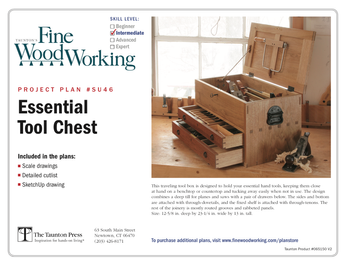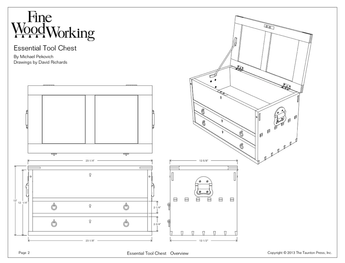If you are ripping a typical flat board on a typical table saw, fence on the right, what is the likely direction and movement of the “projectile” in a kickback situation? Is it an end-over-end launch of the cut-off, and is it to the right or left of the blade? I know that “typical” may be a oversimplification. I am also not asking which side to stand on. Just wondering if the projectile goes straight out or some other way.
TY















Replies
My experience has been that both times I have been injured was when the piece between the fence and saw blade came straight back at great speed. Both were my own fault as I left pieces between the blade and fence while the blade was turning. The second time my thumb went from about 2 1/2 inches to 1 inch in length. Pushed the end back from the knuckle. Ugly as hell but I recovered and am a little wiser, I hope. The moral of the story is keep your outfeed table clear. Merry Christmas to all.
Hi Stan, Both times that kickback occurred with me, I was cutting sheetgoods. 1/4" hardboard and 1/4" ply. Both times I was not doing what I should have been doing. I.E. using my board buddies and feather boards. Thought I would just "make a quickie cut".
I have a small scar on my abdomen from the hardboard and I My right hand has 1/2" lacerations in three places from the ply (thought it broke my wrist initially).
In both cases the piece left between the fence and blade after the cut was complete ( Milliseconds after...) was caught and spun on top of the blade which caught it and flung it at me at 110 MPH. A deep arcing slash resulted in the workpiece.
Scary.....and painful. Could have been worse I Suppose.
Brian
Stan it can be either the cut-off or the full piece which is thrown back at you (i.e. it come backwards/upwards AS A RULE). The simple solutions are to use a riving knife or splitter behind the blade, adopt the European-style short fence (which ends level with the first teeth of the blade - so trapping is almost impossible) and use a push stick or push block to finish the cut. A crown guard or overhead guard will further protect you from the workpiece being lifted off the table if a kickback occurs.
Scrit
Any suggestions or sources for the European short fence and riving knife?
Paxton,
To make a short fence, you can add a second face to the fence you have now, somebody here can probably suggest the proper length for the added fence piece.
European type riving knives can't be attached to Unisaw type cabinet saws or contractor's saws made in the U.S., Canada, or their Taiwanese clones, because these saws don't have the necessary components in the arbor and trunnion assembly to mount the knife so that it moves with changes in blade height.
The Ryobi BT 3100 benchtop saw, and possibly some others, can be fitted with Euro style riving knives, but the knife would have to be shop made.
John W.
Edited 12/23/2003 3:18:14 PM ET by JohnW
I think it is interesting that the "better" American saws like the Unisaw and the Powermatic do not have riving knives, but this feature is found on some of the "lower-end" saws.
You mention the Ryobi BT3100. I also found that other "low-end" saws have riving-knife style guards. For example, the Bosch benchtop saw has a splitter that raises and lowers with the blade, so it stays on a proper plane with the cutting height. The Ryobi is a bit better, but the mechanism on the $500 Bosch benchtop saw is better than the one found on the $2,500 Powermatic.
This is confusing to me...
Paxton, the nearest US equivalent to the European style fences is the Delta Unifence version of the style. It's also easy to emulate the short rip fence style by making a false fence out of wood (or man made board materials) that fits on or over the standard long fence and is attached firmly to it. A convenient thickness for the attached or false rip fence is handy, such as 1" or 2" so that setting the standard fence to a width of cut is easy, e.g., if your false fence is 2"thick and you want to rip 6"wide, simply set the gauge to 8". The false short fence ideally would be adjustable front and back so that it should hold the wood against the blade to a point just beyond (about 12 mm maybe) where the front downward cutting teeth have finished the cut.
Having worked in both Europe and the US as a furniture maker, and used both styles of fence, I've never fully worked out why the long style fences popular in the US ever got to be popular, except that they're convenient for use with a dado blade, a tool I don't use, and other similar operations.
I generally loathed the long fence from the moment I first saw one some ten years ago, but my perception at that time might have been coloured by the fact that that long fence was coupled as usual with a completely exposed and unguarded saw blade, which brought graphic images to mind of the many potential situations conducive to kickback, but there ya go, ha, ha. Slainte.
Website
Edited 12/23/2003 3:43:46 PM ET by Sgian Dubh
Sgian,
Thanks for the direction. I think that I will be busy over the weekend fabricating an attachment for my Unifence! I have been kickback-free for the last 20 years, and would like to keep the streak going for at least another 20. It does seem as if the long fence was designed to create additional problems. Now, if I could just get some good stout for the Holidays! Have a great Christmas!
Paxton
Edited 12/24/2003 9:31:34 AM ET by Paxton
Stan,missiles leave the saw commonly in either of two directions:If trapped between the blade and fence,straight at you contained by the blade and fence;Sheet goods and wide boards especially when making shallow cuts,dados(yes dados!)the material is grabbed by the back(rising teeth)and rotated away from the fence wherupon it comes at you in an arc to disembowel you or at least cramp your sexual prowess for some time.Seriously though,take note of the postings in this forum but don't get paranoid, that in itself can lead to accidents.Forums tend to work themselves up into a crescendo as people recount their own experiences.Living is dangerous to your health stupidity and lack of common sense increases the risks
Take a look at Lon Schleining's on-line article here at Taunton:
http://www.taunton.com/finewoodworking/pages/w00066.asp
Thorough explanation, plus video of kickback as it happens.
forestgirl Another proud member of the "I Rocked With ToolDoc Club" .... :>) you can take the girl out of the forest, but you can't take the forest out of the girl ;-)
I find it interesting (not to say rather worrying) that the demonstrator does not mention the extra protection afforded by a crown guard and a riving knife or splitter....
Scrit
Strange looking video. Every video I ever watched actually moved. Otherwise it would just be a series of still shots.
No matter where you stand, no matter what you use to protect yourself, a piece of material flying off the saw will find you. Sometimes directly, sometimes as a ricochet, but it will find you. The only way to truly prevent this from happening is to have someone there to help you manage the material. Then, when thepiece flys off there is only a 50-50 chance you will get it instead of your helper.
Thanks for all the input. Forestgirl, that link was very helpful - now I understand how your hand can be pulled to the blade by the rotation of the workpiece.
The reason I was asking is that a long time ago, before I knew anything about saws or kickback, I saw a table saw set-up, where the guy had removed the guard and splitter. Instead, he had a homemade steel guard (angle iron?), mounted to the ceiling rafters, hanging vertically over the blade. At the end, directly over the blade, were a couple of horizontal bars, perpendicular to the blade. The whole assembly was movable. He called it a deflector, and did mostly sheet goods. Reading the recent threads, I was wondering if that was in fact a useful tip. I can see it helping with the up-and-over movement, but not necessarily the right-back-at you event. Hmmm, maybe combined with the oak codpiece. . .
BTW, I have a BT3000 which I chose over the more expensive saws I could afford, because it had a true riving knife. I'm working on the short fence now.
TY
I've only experienced kick-back (from a table saw, that is, LOL) once. I wish I could remember more of the particulars for you. I can tell you the the piece left the table at something ~ 30 - 40 degrees from horizontal, and slammed into the sill/joist/rim joist right below where shmtmh was sitting. Scared her half to death. Me too! A more horizontal launch would have sent it right through the cellar door.
I had kickback from stupidity a year ago or so. It was a 1/8" square piece, the fall off from the 2d cut on a rabate. It launched at about 10 to 15 degrees up from horizontal, and straight back, and fast! It hit square onto the drawer divider of a chest I was building of white oak, and the strip was also white oak. Left a clear dent in the wood, maybe about 1/3 - 1/16" deep, the remnants of which are still on the piece, now delivered. It was a gift, not a commission.
I recognize that this is not the safest way to make that cut, but with the edge against the fence, one cannot cut too deep. I was, of course (: standing to the side, which I alwys do whenever possible.
Alan
Sarge put up a picture of his BT3000 with a short fence a while ago:
http://forums.taunton.com/tp-knots/messages?msg=14320.33
I'm guessing here, but the fact that he worked mostly with sheet goods might be why he designed his "deflector" the way he did. A large-ish panel of plywood could do some pretty impressive aerial acrobatics during a kickback episode. Given the right width of stock, I'd think it could flip up and around. A "deflector" might help with that. Seems like his design would have been based on experience (nasty experience).
Talking to a guy on the ferry after the woodworking show last year -- he told me of a KB episode that happened when he was working in a cabinet shop, sawing a large piece of plywood. Sounded like the piece lifted and spun around, taking his hand directly over the blade. What saved him was the plywood itself -- the cut in the plywood was within microns of going all the way through. forestgirl Another proud member of the "I Rocked With ToolDoc Club" .... :>) you can take the girl out of the forest, but you can't take the forest out of the girl ;-)
stantheman
The deflector you refer to is nothing more than a jury rigged "crown" gaurd. Crown= top! It is just not attached to the curved portion of the riving knife as he only has a splitter equipped with his saw. You stated it would move from position to position. That's to adjust to blade height. It should sit just over the top of the blade about 1/16" or 1/8" at max. This comes automatically with a combo riving knife and crown gaurd as they both move with the mechanizm that moves the blade up and down and side to side.
With that BT 3000, just drill two holes in the top of the riving knife or use the two current holes that are already there. You will have to remove the rivets that hole the plastic gaurd and pawls. Those rivets removed will give you two holes you need. The most important thing is too remember that if you use both Thin Kerf blades and regular 1/8" blades, the riving knife must clear the kerf slot that the blade produces.
I had two custom riving knives machined. One is 3/32", the size of the Thin Kerf maximum width and the other is 1/8". the size of a standard blade. If I had the 1/8" riving knife on the saw and switched to a 3/32" TK blade, the cut kerf is too narrow to clear the 1/8" knife and I got a problem caused by my failure to understand mathematics. ha.. ha...
Regards...
sarge..jt Proud member of the : "I Rocked With ToolDoc Club" .... :>)
Sarge
I've been studying the pictures you've previously posted on your set-up. Thanks for the suggestions and the ideas.
Stan
Stan
Yor're welcome! Any questions, let them be known..
Regards...
sarge..jtProud member of the : "I Rocked With ToolDoc Club" .... :>)
This forum post is now archived. Commenting has been disabled